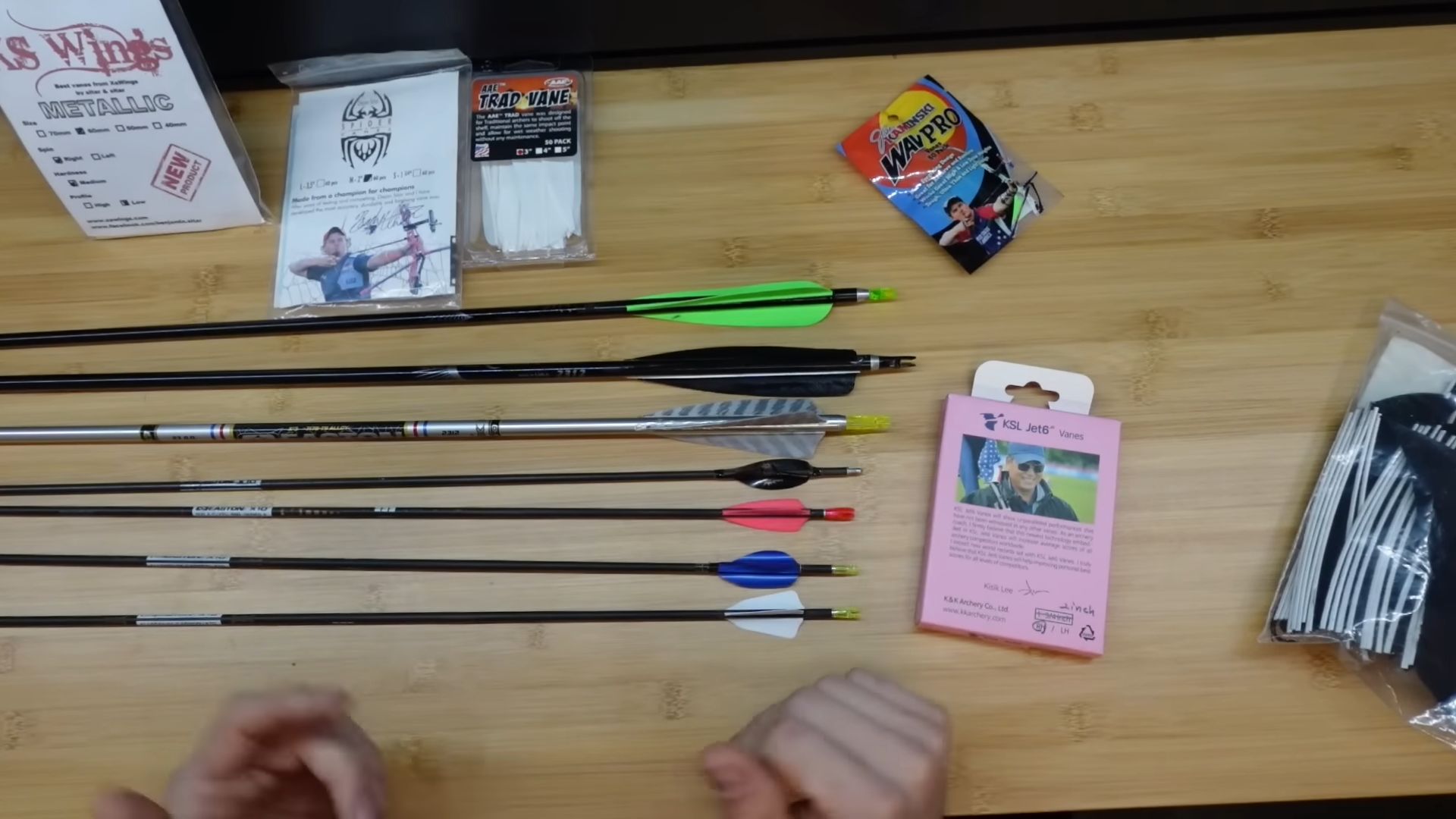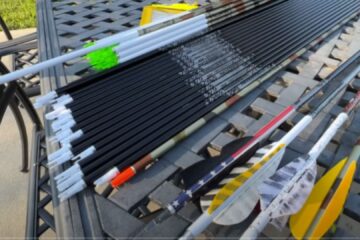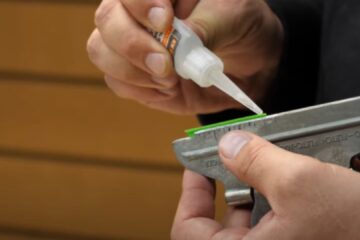Feathering an arrow means to adjust the fletching to correct its flight path. This technique involves tweaking the angle of the feathers so that the arrow maintains better stability in the air.
Archers have been feathering arrows for centuries. The goal is to improve the arrow’s accuracy and distance by making sure it flies through the air smoothly. The feathers, or fletching, are the small vanes attached to the end of the arrow that help stabilize it in flight.
Feathering an arrow involves adjusting these vanes to make sure the airflow around them is optimal, reducing drag, and ensuring a straight and precise flight. This process is essential for those who want to improve their archery skills and hit the target with more consistency. By feathering the arrow, the archer can improve his or her shooting accuracy, making it an integral part of the sport.
Understanding The Anatomy Of An Arrow
Feathering an arrow is a vital component when it comes to archery. Understanding every aspect of an arrow is essential, starting from the anatomy of the arrow. By doing so, you can enhance your skills as an archer and improve your aim.
Parts Of An Arrow
An arrow is made up of several critical parts, which include the following:
- Point
- Shaft
- Fletching
- Nock
The Function Of Each Part
Each part of an arrow has its own function. Understanding the function of each part helps you determine the ideal arrow for your shooting needs. The following are the functions of each part:
- Point: This is the arrowhead, and its main function is to penetrate the target. It comes in different shapes, including field points, broadheads, and blunt points.
- Shaft: It is the body of the arrow and determines the arrow’s weight, stiffness, and durability. It is usually made of wood, aluminum, carbon, or a combination of materials.
- Fletching: These are feathers or vanes attached to the rear end of the arrow. The fletching’s primary function is to stabilize the arrow while in flight, making it spin for better accuracy.
- Nock: It is situated at the rear end of the arrow and serves as the arrow’s fitting into the bowstring. The nock’s function is to lock the arrow into place until the shooter releases it.
Understanding the anatomy of an arrow is significant for every archer. The arrow’s functionality and performance rely heavily on each part’s design and quality. Therefore, ensuring that each part is functioning correctly will help increase an archer’s success during shooting.
Choosing The Best Feather For Your Arrow
Feathering An Arrow: Choosing The Best Feather For Your Arrow
Feathers play a crucial role in archery, as they impact the accuracy and trajectory of arrows. Selecting the right type of feathers can be overwhelming, considering the multitude of options available. Here, we will discuss what to consider when choosing the best feather for your arrow and the different types of feathers available.
What To Consider When Selecting Feathers
Before selecting feathers for your arrow, consider the following factors:
- Purpose of the arrow: Are you using the arrow for hunting or target shooting? Feathers with longer length are better suited for hunting, while shorter feathers are ideal for target practice.
- Bow draw weight: The draw weight of your bow also affects feather selection. Heavy draw weight bows require stiffer and stronger feathers to stabilize arrows.
- Shaft diameter: Feathers of the appropriate size should be selected based on the arrow shaft’s diameter.
Different Types Of Feathers For Arrows
There are three main types of feathers used for arrows:
- Parabolic feathers: These are the most common feathers used in archery. They have a curved and wide shape, providing stability and accuracy to the arrow. Parabolic feathers are best for target shooting and indoor archery.
- Shield feathers: Shield feathers are longer than parabolic feathers, and provide better stability to arrows in flight. They offer excellent accuracy and less drag than parabolic feathers. Shield feathers are ideal for hunting arrows as they help the arrow to travel at higher speeds.
- Straight feathers: Straight feathers offer minimal stabilization and are lightweight, making them ideal for target shooting archers. They are also useful for shooters who have a low draw weight bow, as they offer less drag and more speed to the arrow.
Selecting the right feather for your arrow is crucial to achieving accuracy and stability in archery. By considering the purpose of the arrow, bow draw weight and shaft diameter, you can narrow down your choices. Moreover, choosing between parabolic feathers, shield feathers, and straight feathers depends on your preference, shooting style, and the type of archery you enjoy.
Feathering And Fletching Techniques
Feathering An Arrow: Feathering And Fletching Techniques
One of the most important aspects of archery is ensuring your arrow is as accurate as possible. Feathering and fletching techniques play a significant role in how your arrow flies and where it lands. By using traditional or modern techniques, you can customize the fletching to your liking and achieve better results.
In this blog post, we will explore both traditional and modern fletching methods.
Traditional Fletching Methods
Traditional fletching methods have been around for centuries, and although modern techniques have emerged, they are still popular among archers. Here are some of the key points:
- Feathers from a bird’s wing or tail have been popular materials for traditional fletching.
- The shaft is normally made using both wood and bamboo materials.
- Traditional arrowheads were produced using stones such as flint and obsidian in the past.
- A fletching jig is used to help set the feather in place while glue dries.
- The spacing between each feather or vane determines how much stabilization your arrow will have.
Modern Fletching Techniques
Modern fletching techniques have emerged in recent years, and they offer a wider range of options to archers. Here are some of the key points:
- Synthetic materials, such as plastic, are commonly used for making arrow shafts.
- Carbon-fiber arrows have become more popular due to their lightweight characteristic.
- An adhesive is used for attaching the synthetic fibers or vanes to the arrow shaft.
- Some manufacturers provide pre-made fletchings, while others allow archers to customize their own.
- Fletchings come in various shapes, sizes, and angles to achieve the desired stabilization.
Feathering and fletching techniques are two important aspects of archery. Traditional methods have been useful for centuries, while modern methods are more versatile and provide a range of options. As an archer, choosing the right type of fletching and feathering technique depends on your individual preferences and what works best for you.
Tips For Perfecting The Art Of Feathering An Arrow
Feathering an arrow: tips for perfecting the art of feathering an arrow
Feathering an arrow is an essential technique for archers. If done correctly, it can help increase the accuracy and stability of your shots. However, if you don’t know how to feather an arrow, or worse if you damage the feathers during the process, you might end up with an ineffective arrow.
To help you avoid this, we’ve compiled a set of tips on how to feather an arrow without damaging the feathers and some common mistakes to avoid.
How To Feather An Arrow Without Damaging The Feathers
Feathering an arrow can be a daunting task, especially for beginners. Follow these tips to make sure you are doing it right and without damaging the feathers:
- Use protective gear such as gloves to avoid any accidents.
- Sand the shaft of the arrow where the feathers will be glued. This will ensure that the surface is smooth and the glue will stick better.
- Apply a small amount of glue on the base of the feather and then place it on the shaft. Make sure it is aligned properly.
- Press the feather gently for a few seconds to make sure it is securely glued.
- Repeat the process for all the feathers on the arrow.
By following these steps, you can feather an arrow without damaging the feathers and increase your chances of hitting the bullseye.
Common Mistakes To Avoid During Feathering
As with anything new, there are some common mistakes archers make when feathering an arrow. Here are a few of them that you should avoid:
- Using too much glue can create a mess and damage the feather. Using a small amount of glue is enough.
- Not aligning the feather properly can lead to an unbalanced arrow, affecting the accuracy.
- Putting too much pressure while pressing the feather can damage it.
- Using blunt scissors to trim the feathers can cause them to tear. Always use sharp scissors or a cutter.
- Not keeping the feathers clean can affect their lifespan, and it can also affect the arrow’s stability.
Avoiding these mistakes will ensure you have perfectly feathered arrows that will perform better during your archery sessions.
Feathering an arrow might seem like a small aspect of archery. However, mastering it is crucial for improving your accuracy and stability while shooting. By following the tips and avoiding the mistakes mentioned above, you can perfect the art of feathering an arrow and step up your archery game.
Frequently Asked Questions Of Feathering An Arrow
How Important Are Feathers In Archery?
Feathers help guide the arrow in flight, stabilize it, and improve accuracy. They also create drag, slowing down the arrow’s speed for a more consistent shot. Feathers are a crucial component in archery and play a significant role in the performance of the arrow.
How Do You Attach Feathers To The Arrow?
The feathers are glued onto the arrow shaft using fletching glue. The most common way of attaching the feathers is by positioning them at 120 degrees around the shaft. Beginners can use a fletching jig to make the task easier and ensure that the feathers are evenly spaced and aligned.
What Is The Purpose Of Feather Color?
Feather color isn’t just for aesthetics. The different colors of the feathers help to distinguish between arrows, making it easier to track them and identify your own in a group setting. It’s also important in competition as well, as some tournaments require different colored feathers for scoring purposes.
Conclusion
After reading this blog post, it’s clear that feathering an arrow is a crucial aspect of archery that should not be overlooked. For those new to the sport, it’s important to understand the purpose of the fletching and the different types available.
Whether you choose to use natural or synthetic feathers, it’s important to take into account the weight and length of the arrow as well as your own individual shooting style. Practice and experimentation may be necessary to find the perfect feathering for your arrows.
By taking the time to properly feather your arrows, you’ll likely see an improvement in your accuracy and overall performance as an archer. Don’t underestimate the power of a well-feathered arrow in hitting your target with precision and consistency. Happy shooting!






